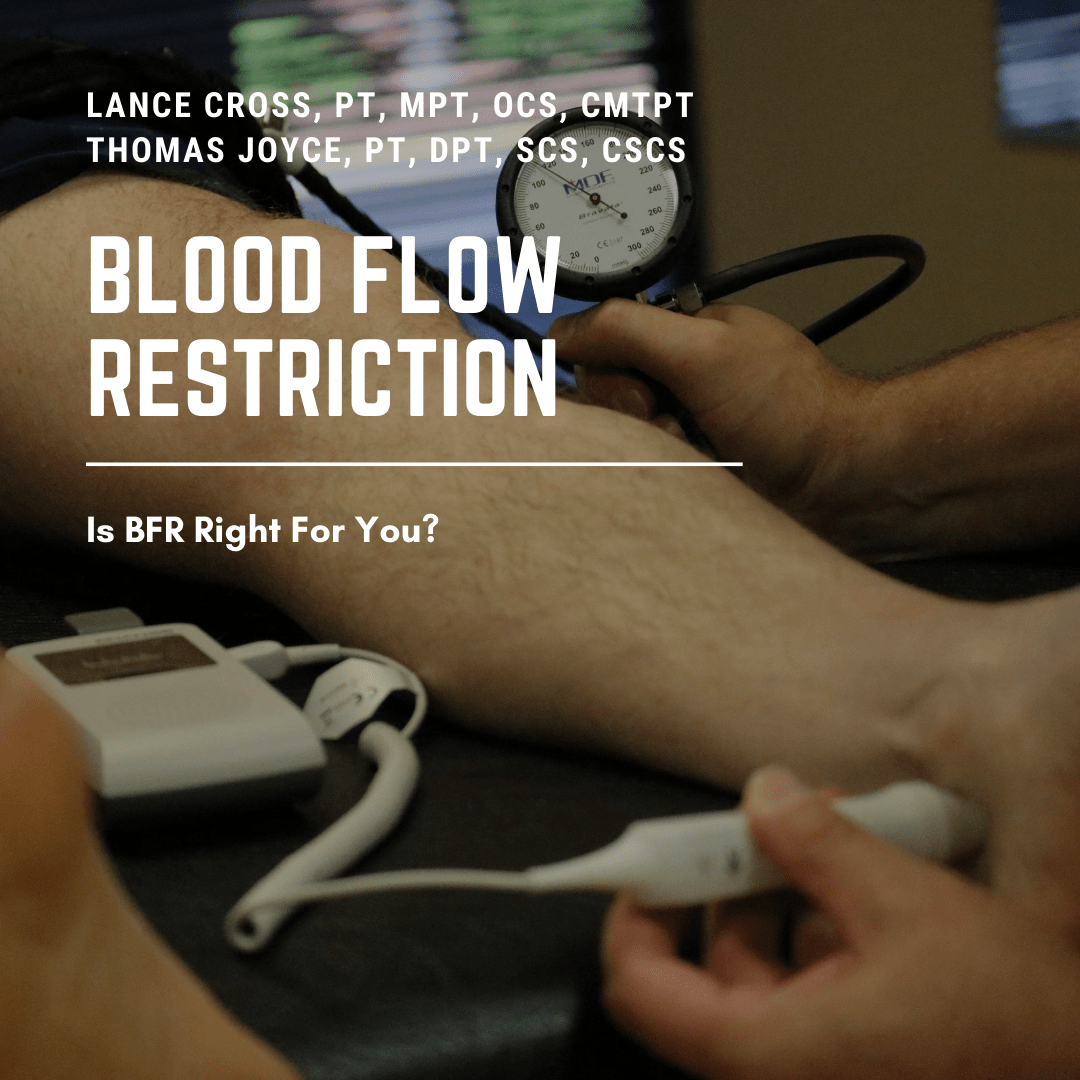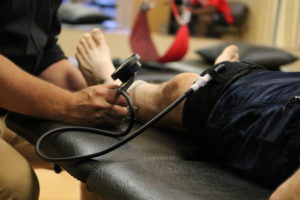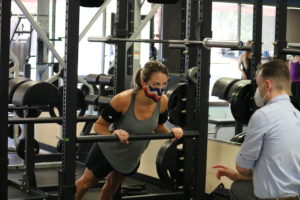Blood Flow Restriction

Blood Flow Restriction: Is It Right For You?
Is Blood Flow Restriction right for me? This question has recently become more common as the medical community has become increasingly aware of this powerful treatment modality. In this blog, we will detail Blood Flow Restriction, how it works, and how it might help you rehabilitate from injury or a pain process.
What Is Blood Flow Restriction Training?
 Blood Flow Restriction (BFR) training in the clinical setting involves the use of a FDA Class I regulation medical tourniquet device during low intensity exercise. This device reduces blood flow to and from working muscles in a safe and customized manner that the therapist will calculate and monitor. An ultrasound doppler allows the therapist to carefully determine the individual’s limb occlusion pressure (LOP). This customizes the pressure to the individual, which is referred to as Personalized Blood Flow Restriction (PBFR), and making the BFR intervention safer and more effective.
Blood Flow Restriction (BFR) training in the clinical setting involves the use of a FDA Class I regulation medical tourniquet device during low intensity exercise. This device reduces blood flow to and from working muscles in a safe and customized manner that the therapist will calculate and monitor. An ultrasound doppler allows the therapist to carefully determine the individual’s limb occlusion pressure (LOP). This customizes the pressure to the individual, which is referred to as Personalized Blood Flow Restriction (PBFR), and making the BFR intervention safer and more effective.
What Are The Benefits Of PBFR?
 Personalized Blood Flow Restriction results in much greater gains in muscle growth (hypertrophy), strength and endurance while exercising at a much lower intensity or weight for a particular exercise. Research has repeatedly shown these gains to be much more profound compared to the gains seen with low intensity exercise with normal blood flow. Even more impressive, these gains are comparable to the gains made with high intensity and heavy load exercise. PBFR is also used to limit pain and can be used to help prepare an individual for exercise. Additionally, PBFR is proving to create a much greater degree of healing in injured muscle, tendon, and bone as compared to normal healing.
Personalized Blood Flow Restriction results in much greater gains in muscle growth (hypertrophy), strength and endurance while exercising at a much lower intensity or weight for a particular exercise. Research has repeatedly shown these gains to be much more profound compared to the gains seen with low intensity exercise with normal blood flow. Even more impressive, these gains are comparable to the gains made with high intensity and heavy load exercise. PBFR is also used to limit pain and can be used to help prepare an individual for exercise. Additionally, PBFR is proving to create a much greater degree of healing in injured muscle, tendon, and bone as compared to normal healing.
Common Conditions That Benefit From PBFR: 
- Pulled Muscles/Muscular Strains
- Following orthopedic surgery (Total Knee/hip Replacements, Rotator Cuff Repair, etc.)
- Tendinopathy (AchillesTendon Tendinosis, Posterior Tibialis Tendon tears, partial rotator cuff tear)
- Weakness of musculature after injury
- Fracture of bone
- Pain
What Are The Physiological Effects Of PBFR?
- Down regulates myostatin, which is chemical that prevents muscles from growing.
- Increases Human Growth Hormone, which promotes healing of tissue.
- Increase Vascular Endothelial Growth Factor, which promotes improved capillary density formation in an injured area.
- Increased mTOR (mammalian target of rapamycin) positively regulates actin filament polymerization and skeletal muscle hypertrophy.
- Increases IGF-1 (Insulin Like Growth Factor) – Stimulates fusion of satellite cells into existing muscle fibers
- Increases recruitment or activation of motor nerve fibers to a muscle.
In Summary
Personalized Blood Flow Restriction Training can be a game changer when rehabilitating a muscular, tendinous, or bony injury. There will be other treatments needed to correct the dysfunction as well, but the use of PBFR will allow for faster and more thorough exercise progressions. If you’re interested in incorporating Personalized Blood Flow Restriction training into your rehabilitation, contact One on One Physical Therapy at 770-500-3848 to consult one of our experts to get you walking, running or jumping down the road to recovery.
About The Authors
 Lance Cross, PT, MPT, OCS, CMTPT at One on One specializes in the use of Personalized Blood Flow Restriction for the treatment of individuals with chronic musculoskeletal injuries such as tendon tears and arthritis. He has been involved in research regarding chronic pain treatment and lectures to the Emory University Doctorate of Physical Therapy Program on the topic. Lance’s unique experience, education and skills have helped him to refine a highly effective approach that is greatly benefiting those who are dealing with chronic pain.
Lance Cross, PT, MPT, OCS, CMTPT at One on One specializes in the use of Personalized Blood Flow Restriction for the treatment of individuals with chronic musculoskeletal injuries such as tendon tears and arthritis. He has been involved in research regarding chronic pain treatment and lectures to the Emory University Doctorate of Physical Therapy Program on the topic. Lance’s unique experience, education and skills have helped him to refine a highly effective approach that is greatly benefiting those who are dealing with chronic pain.
 Thomas Joyce (TJ), PT, DPT, SCS completed the Sports Physical Therapy Residency at the Ohio State University. He received his Doctor of Physical Therapy Degree from Duke University and is a Certified Strength and Conditioning Specialist and a Certified Olympic Weightlifting Coach. He has a passion for working with high school, recreational, collegiate, and professional athletes across many sports and enjoys working with athletes of all ages. TJ used Personalized Blood Flow Restriction to treat athletes with both acute injuries and chronic musculoskeletal conditions to promote an expedited return to activity.
Thomas Joyce (TJ), PT, DPT, SCS completed the Sports Physical Therapy Residency at the Ohio State University. He received his Doctor of Physical Therapy Degree from Duke University and is a Certified Strength and Conditioning Specialist and a Certified Olympic Weightlifting Coach. He has a passion for working with high school, recreational, collegiate, and professional athletes across many sports and enjoys working with athletes of all ages. TJ used Personalized Blood Flow Restriction to treat athletes with both acute injuries and chronic musculoskeletal conditions to promote an expedited return to activity.
